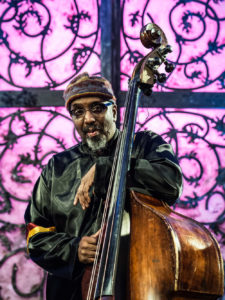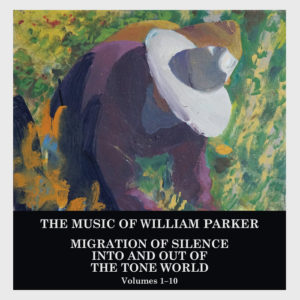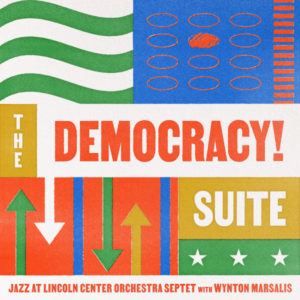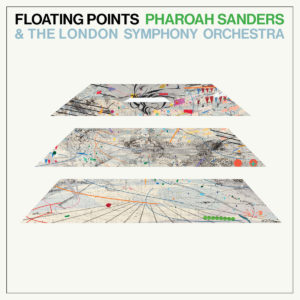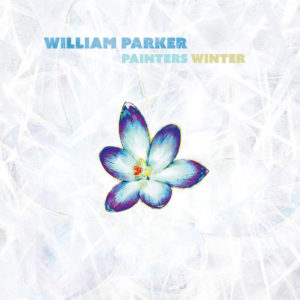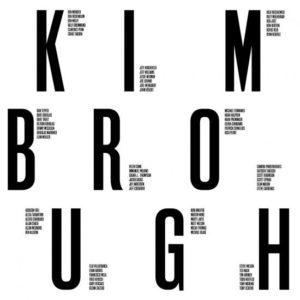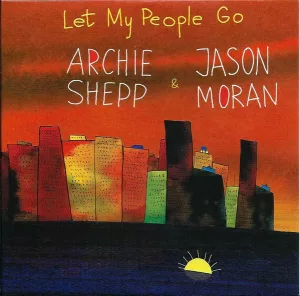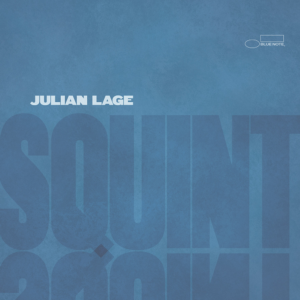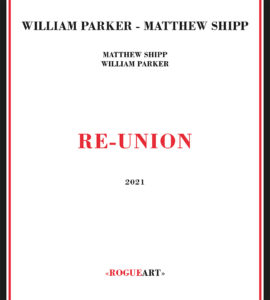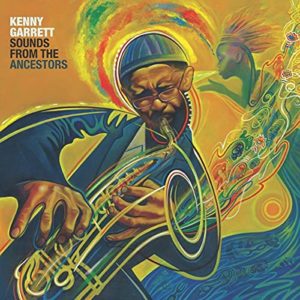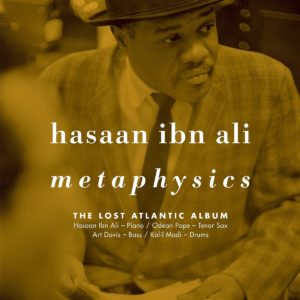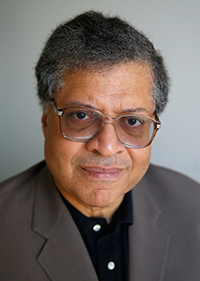I’m not altogether sure what it says about this year – or, rather, my year – in jazz that for the first time since I started putting these things together, a single artist dominates my annual list as William Parker does this one. It’s not as though he’s an overnight sensation; he’s been a redoubtable and influential fixture on the progressive jazz scene since the 1970s when the music’s cutting edge could be found working through its experiments in big-city lofts. But his impulse to outwork, out-produce and out-gig his peers both within and outside the (so-called) avant-garde has been especially apparent this year, not just with the significance of the ten-disc omnibus that leads the list (see below), but in the appearance during the past 12 months of at least six albums bearing his name, including three that are also on the list. (5, 6 and 10) It helps that Parker is something of a polymath: a grandmaster of the upright bass with a formidable body-of-work as a composer along with an ability to express himself on many other instruments and an accomplished, if relatively unsung poet. From reading Cisco Bradley’s Universal Tonality: The Life and Work of William Parker (Duke University Press), also published this year, one gets the impression that irrepressible curiosity and a multiplicity of interests are among the things that drive Parker forward. I’m sort of thinking that most of us who have struggled throughout 2021 to recuperate in various ways from 2020 while still feeling wary and uneasy about what’s happening now and whatever’s ahead could profit from the example set by somebody like William Parker, who at 70 has cultivated and honed his craft to a glistening edge while retaining an active abhorrence of injustice, a profound sense of cultural history and a steadfast, self-effacing core of spiritual equilibrium.
Most of the other artists on this year’s list have in different ways released albums that convey those same values. Some are declarative in expression, others more contemplative. They engage the prevailing disquiet, not (necessarily) in anger, but with a determination to face turbulence and dread with clarity and understanding. (I almost said “correctness.” I refuse to say “woke.” Never mind why.)
Also: if you’d somehow found my 20-something self under siege in the seventies and told me that more than a half-century later, albums headlined by both Pharoah Sanders and Archie Shepp would be included among my personal top-ten list, I’d have said you were either daft or irrationally optimistic. Their octogenarian triumphs make me wonder whether, “irrational optimism” is a legitimate and necessary response to whatever’s now threatening us all, whether from nature or from humans. It may well be that both Sanders and Shepp persist because they’re both still somehow necessary to fight the power in their different ways. Feel free to suggest that in another few decades, four of Wynton Marsalis’ albums will find their way to the upper half of such lists, assuming we’ll still have albums, or lists, or…
No. Let’s not go to there. We’re going to try “irrational optimism” for a while longer. At least, I am.
1.) The Music of William Parker, Migration of Silence Into and Out of the Tone World, Volumes 1-10 (AUM) – On its own, this imposing gallery-without-walls is a Top-10 list. And not just for jazz, but also for world music, art songs, soundscapes and “spoken poetry.” Think of it also as a ginormous prism that, when held to natural light, emits wildly varying arrays of color and echo. The first volume, “Blue Limelight,” sets the table for its successors as Parker’s musical autobiography suffused with childhood memories and dreams (“Cosmic Funk,” “A Great Day to Be Dead”) and reminiscences of such colleagues as Cecil Taylor and lesser-know-but-still-legendary Hoboken trumpeter Bennie Bishop. The remaining volumes comprise a portable universe of possibility – and of orchestration: a whole disc of solo piano pieces played by Eri Yamamoto taking off from some of the composer’s personal iconography (Malachi Favors, Malcolm X) and his abiding engagement with Native American history and culture; another volume, “Cheops,” whose title track is named after an Egyptian pyramid, places in its foreground the startling range and pyrotechnics of vocalist Kyoko Kitamura with Parker not only playing bass, but also a bass dudek (an ancient Armenian double-reed instrument) and fujara (a “fipple flute,” tall enough to stare down a bassoon). The composer provides plenty of space for voices to lay out, notably on a volume where Lisa Sokolov does a stunning a capella recital of Parker’s “Afternoon Poem.” Parker throughout is less of a presence on bass than he is on other such exotic instruments whose deployment emerges in all manner of settings whether they are reveries of Harlem, Mexico or the films of Fellini, Visconti, Antonioni, and other Italian filmmakers (“Lights in the Rain.”) To find the best encapsulation of this ambitious collection, you need to go all the way back to the first volume’s third track, “I’d Rather Be” in which this titan of what is still regarded as jazz’s “avant-garde” has a character from one his “tone poems” declare that she “would rather be a human being than be avant-garde [because] the most avant-garde thing you can be is a human being.”
2.) Jazz at Lincoln Center Orchestra Septet with Wynton Marsalis,The Democracy! Suite (Blue Engine) – The leanest, tightest, toughest-minded music released under Wynton Marsalis’ name in decades made its public debut in the Appel Room of J@LC’s Frederick C. Rose Hall in September 2020, just about the time when the shattering events of that year were propelling the nation towards its Election Day rendezvous with destiny. There was no live audience because of the COVID-19 lockdown. But there’s urgency, momentum and focus merging together in Marsalis’ eight-part composition in ways not often encountered in his previous work. The first track, “Be Present,” is as declamatory as its title, throwing punches at the prevailing chaos without flailing. Once this group has your attention, it keeps up the pace with “Sloganize, Patronize, Realize, Revolutionize (Black Lives Matter),” a piquant rouser upon which Marsalis’ old boss Art Blakey would have pounced with polychordal brio. Of the ensemble’s soloists, J@LC mainstay Walter Blanding makes his tenor sax growl deep and dissonant on this track, in case there’s any doubt that Marsalis and his men are out to kick Trumpism in the teeth. But it’s not all grievance and exasperation. Things perk up with “Ballot Box Bounce” anchored by reed master Ted Nash’s breezy rendering on flute of Marsalis’ witty melody and “That Dance We Do (That You Love),” with Blanding, Nash, trombonist Elliot Mason, pianist Dan Nimmer, drummer Obed Calvaire, and bassist Carlos Henriquez helping their leader here and elsewhere make his most emphatic case yet for jazz being the consummate expression of, and metaphor for the democratic process: individual freedom flourishing within the collective imperative. And if the resilience of that paradox isn’t clear to all, or even some, Marsalis composes a movement for that, too: “It Come ‘Round ‘Gin.” As everything, good, bad, and indifferent, always does in America.
3.) Veronica Swift, This Bitter Earth (Mack Avenue)— For Swift, the classic pop song repertoire is more than an arena for her fearsome vocal agility. It is also a mode of interrogation, an agency of dissent. Think of how her sister Millennial phenom Cecile McLorin Salvant assembled a concept album of standards, 2015’s For One to Love, illuminating the often-casually toxic quirks of the male gaze. The title track of Swift’s latest album, which until now seemed the sole property of Dinah Washington, signals thoughtful and passionate engagement with the anxious present. She applies shading and intensity to the Clyde Otis dirge, which at once contains its majesty while maximizing its power. It’s an exquisite balancing act that sets the table for the creative and virtuosic renditions of stage musical standards and such Brill Building oddities as “He Hit Me (And It Felt Like a Kiss),” Carole King and Gerry Goffin’s disquieting dissection of abusive love, which she sings to the stark accompaniment of Armand Hirsch’s guitar. She carries this inquiry into questionable behavior between the sexes to such grand old war horses as “As Long as He Needs Me” from “Oliver!” and “How Lovely to Be a Woman,” from “Bye Bye Birdie,” whose effervescent interpretation barely conceals the gimlet-eyed contempt for its implicit sexism. She trains her sights on racism with Rodgers and Hammerstein’s “You’ve Got to Be Carefully Taught,” which is immediately, but no less trenchantly (or imaginatively) countered with that same duo’s “Getting To Know You.” Her range of concerns is as deep and wide as her vocal resources, taking in Bob Dorough’s bopping “You’re the Dangerous Type” and Dave Frishberg’s “The Sports Page,” cheekily summing up why so many of us seek refuge in scores and highlights from the exasperations of whatever “hard news” delivers. The present spreads all over This Bitter Earth. But Swift’s mesmerizing chops remain Beautiful and True in any time frame.
4.) Floating Points & Pharoah Sanders featuring the London Symphony Orchestra, Promises (Luaka Bop) – OK. John Coltrane’s Ascension, right? Pharoah Sanders was one of the eleven musicians who played on that landmark 1965 album that drew a line in the sand between those who were totally onboard for the Free Jazz rocket flight and those who wanted no part of it. After a six-decade career which he began as an avatar for “outside” saxophone inventions, Sanders, now 81, aligned himself with British electronic music artisan Sam Shepherd, alias Floating Points, who composed a nine-part suite he and Sanders recorded with the LSO not long before everything locked down. So, what does the tempestuous Ascension, which I’ve routinely characterized (in a good way) as a “sonic maelstrom” or a “polyphonic orchestrated abstraction” have in common with a sequence of suggestive, near-pastoral impressions? (A glibly convenient, if not terribly useful shorthand description might be, “trance music with soul.”) For one thing, both works take off from a simple progression of notes that become an ongoing riff: Ascension takes off from five while Promises sets sail from seven. Each work also wears its own brand of inscrutability, daring you to poke around its layers, resisting any effort towards “understanding” what makes each of them tick. With Promises, there are tensions winnowing throughout between space and time, declaration and insinuation, abandonment and resolve. Sanders’ voice, downier, warmer, but every bit as probing and incantatory as it was when he was in his mid-twenties, is what carries you along the contours laid out by Shepherd’s keyboards and the LSO’s strings. (At various points, you hear the saxophonist’s gentle singing voice seeping into the mixture with his own non-verbal lyrics.) On the whole, the album delivers nowhere near the same kind of intensity associated with Ascension. It is a far subtler, more enchanting, and comparably provocative experience that coerces repeated listening in search of more secrets, not resolutions necessarily, just more secrets.
5.) William Parker, Painter’s Winter (AUM)
6.) William Parker, Mayan Space Station (AUM) – Two very different trios make the case for Parker’s mastery of both his principal instrument and of guiding small bands of any size towards expansive and productive interplay. With electric guitarist Ava Mendoza setting off harmonic firestorms propelled by the equally combustible drummer Gerald Cleaver, Mayan Space Station is redolent of the riveting mosaics of amplified sound forged in trios led by the late Sonny Sharrock. Parker’s bass playing does as much breakaway running as his two partners, though most of the time he’s content to drive this vehicle forward and let their younger people go off. The acoustic trio on Painter’s Window that includes multi-instrumentalist Daniel Carter and drummer Hamid Drake seems a lot more composed. But their collaboration is just as intense and deeply committed with Carter’s solos on trumpet, saxophones and flute unfurling intricate patterns as Drake’s percussive momentum shifty enough to keep up with the indefatigable bassist. Besides Parker, the only quality these two discs share is narrative drive that’s both refined and rugged.
7.) Kimbrough (Newvelle) – Frank Kimbrough died just before last New Year’s Eve at 64, setting off a still-resounding wave of shock and grief from generations of jazz musicians who played with or studied under him. Among these artists, Kimbrough was beloved as a “pianist’s pianist,” a droll and ubiquitous presence on the New York City scene, an archivist tending diligently to the legacies of Herbie Nichols and Thelonious Monk, a crucial member of the critically acclaimed Maria Schneider Orchestra, a devoted teacher who mentored aspiring musicians at NYU and Julliard, and a gifted, uncompromising, and prolific composer. It is mostly to that latter aspect of Kimbrough’s life and work that this extensive, ambitious tribute album was recorded almost six months after his death. There are 61 tracks featuring 67musicians in 55 different combinations. Any random sample of the players involved – Ben Allison, Fred Hersch, Michael Blake, Dave Douglas, Craig Taborn, Joe Lovano, Matt Wilson, Helen Sung, Noah Preminger, among many others – is enough to suggest the breadth and depth of Kimbrough’s influence on his peers and ex-pupils alike. The compositions they play, sometimes on one take and in different versions (“Reluctance” is rendered in solo and quartet form) offer so many revelations as to suggest decades to come of workshops, repertory orchestrations and ensemble performances of Kimbrough’s mostly unsung work spreading out to concert halls and colleges here and abroad. In the immediate aftermath of Kimbrough’s passing, one of his heartbroken friends wondered whether it marked the end of an era or the beginning of a new one. This album’s release reinforces my belief that it’s more the latter. I’m sure Frank would agree.
8.) Archie Shepp & Jason Moran, Let My People Go (Archieball) – There was always something of the old-time spiritual revivalist in Shepp, even as far back as the mid-1960s when he emerged as one of the more stridently political of the emerging tenor saxophonists inspired and nurtured by John Coltrane. At 83, Shepp doesn’t let his phrasings wail with the sustained force he exerted on such classics as 1966s Mama Too Tight, 1972’s Attica Blues or (my all-time favorite) 1975’s A Sea of Faces. His mature style relies more on space and timing, the vocalizing more contained, but no less intense. In this collaboration with the mighty, simpatico pianist Jason Moran, Shepp sings with and without the tenor or (mostly) soprano sax with a depth of feeling that releases itself in bursts, especially in the “sorrow songs” such as “Go Down, Moses” and “Sometimes I Feel Like a Motherless Child.” Shepp’s stark, weathered vocals allow you to hear each line and word with a deeper sense of desolation and yearning on these spirituals and Moran’s own spare and impeccably timed comping provides an elegant frame for Shepp’s arias. On the other tracks, Shepp and Moran are more conversational, their measured, lively exchange of themes and ideas inspiring fresh ways of engaging such familiar standards as Ellington’s and Strayhorn’s “Isfahan,” Monk’s “Round Midnight,” Coltrane’s “Wise One,” Shepp’s own “Ujamaa,” and, in an especially multi-layered rendering, Moran’s own “He Cares.” Shepp’s patented blurts, bleats and squawks flare up over the cushions of chords Moran sets loose or holds back whenever the occasion demands. It often sounds as though both are collaborating on separate dramas with their synchronistical dialogue weaving seamlessly into place. One remembers that back in those 1960s, Shepp was, among other things, a playwright.
9.) Julian Lage, Squint (Blue Note) – Anyone whose curriculum vitae includes gigs with Nels Cline, Charles Lloyd, John Zorn, Bela Fleck, Gary Burton, David Grisman and Yoko Ono should have your attention from the jump. And Lage (pronounced “lahzh,” as in “lozenge”) goes all out on his first release with the fabled Blue Note label to show he can do anything and everything he wants to with a guitar, whether it’s a neoclassical a cappella solo (“Etude”), straight-ahead swing (“Boo Blues,” the title track), classic covers (Johnny Mandel’s “Emily,” Gene Autry’s “Call of the Canyon”), country-rock (“Day and Age,” “Twilight Surfer”). Clearly Lage knows more than a little about a lot of different genres. But he makes his best impression as a player not by leading with his learning or virtuosity, but by gently asserting and maneuvering his own sensibility into each piece. It helps to have a rhythm section of bassist Jorge Roeder and drummer Dave King as smart and attentive to his needs as any great piano trio. Indeed, Lage’s trio has drawn comparisons to Bill Evans’ deathless 1961 Village Vanguard threesome both for the seamless interaction between the principals and the insinuating lyricism. Other influences raise their hands for attention in Lage’s style from Chet Atkins to Pat Martino. But Lage, who first gained notice as an eight-year-old prodigy, is still just getting started and with greater name recognition an all-but-inevitable result from Squint , one gets a little tingly over what he’ll be able to do with even broader resources available to him.
10.) William Parker & Matthew Shipp, Re-Union 2021 (Rogue Art) – Though Parker and Shipp have worked together on several projects with larger groups, this Re-Union marks only the third time they’ve played together as a duo. Their respective personalities blend so well together that it’s surprising they haven’t “re-unioned” more often. As with most friends’ conversations, one of them starts out with something small: a thread, a fragment, a half-baked suggestion, the punch line of a joke neither knows about (yet), any of which could make the other either carry the thought towards a tentative conclusion or veer off into another topic entirely. Which is how I’d best characterize the 22-minute title track that kicks things off. If you’re able to keep up with the exchange, you can start taking measure of the two personalities and how they are or aren’t alike. Shipp’s eccentric, enigmatic combinations of chord clusters follow their own logic while Parker’s austere, but fluid bass lines follow him along when they’re not shoving him in an altogether different direction. Neither seems particularly worried about whether the other lands, though the unwary listener should always be alert for shifts in direction, temperament, maybe an impromptu lull in their transaction before picking up the previous thread or finding a new one. They’re both free spirits in different ways – but not so free-spirited that they forget you’re listening. So be ready when Parker decides to pick up his bow to assert himself more or Shipp re-doubles his efforts to deepen his attack. Think of it as just another afternoon of eavesdropping at the coffee house when voices are raised without warning, but nobody’s mad at anybody.
In this spirit, we leave the last words to both these gentlemen.
HONORABLE MENTION: Kenny Garrett, Sounds from the Ancestors (Mack Avenue); Vijay Iyer, Uneasy (ECM); Henry Threadgill Zooid, Poof (PI); Gerry Gibbs Thrasher Dream Trios, Songs from My Father (Whaling City Sound); Bill Charlap Trio, Street of Dreams (Blue Note) Artifacts (Tomeka Reid, Nicole Mitchell, Mike Reed)…and then there’s this (Astral Spirits)
REISSUE OR HISTORICAL RELEASE: 1.) Hasaan Ibn Ali, Metaphysics: The Lost Atlantic Album (Omnivore) 2.) Roy Hargrove & Mulgrew Miller, In Harmony (Resonance) 3.) Hasaan Ibn Ali, Retrospect in Retirement of Delay: The Solo Recordings (Omnivore)
LATIN: Eliane Elias, Chick Corea & Chucho Valdes, Mirror, Mirror (Candid)
VOCAL: Swift, This Bitter Earth
HONORABLE MENTION: Mary LaRose, Out There (Little Music)
DEBUT: Patricia Brennan, Maquishti (Valley of Search)
